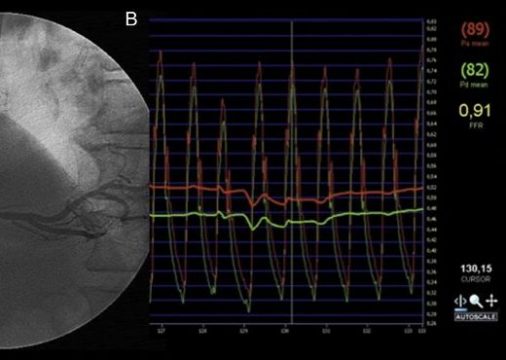The use of fractional flow reserve (FFR) and non-hyperemic pressure indices (NHPRs) have become essential for intermediate lesion revascularization.

A linear inverse correlation has been recently shown between the use of post PCI physiology and cardiovascular events at followup. However, its adoption has been limited so far, seeing the wide variety of algorithms used in assessment studies, some based on optimization according to operator, or on measuring segmental gradients. This last point remains controversial and lacks the validation of prospective studies.
The aim of this subanalysis of the FFR REACT (FFR-guided PCI Optimization Directed by High-Definition IVUS Versus Standard of Care) was to assess the diagnostic performance of segmental post PCI FFR gradients, distal coronary pressure-to-aortic pressure ratio (Pd/Pa), and diastolic pressure ratio (dPR) gradients to detect residual disease observed by IVUS (focal distal or proximal lesions and stent underexpansion).
This analysis included patients that had already undergone successful PCI presenting post PCI <0.90 FFR. Researchers measured FFR, Pd/Pa, and IVUS pullbacks.
Read also: COAPT: Nutritional Condition Is an Important Factor in Edge-to-Edge Treatment.
139 vessels in a total 132 patients were looked at. Mean age was 66 and most patients were men. The most frequently analyzed vessel was the anterior descending (72%), followed by the right coronary artery (16.5%). The most common lesions were type B2/C. Mean post PCI FFR was 0.83 ± 0.05. Distal focal lesions were detected with IVUS in 17.4% of cases, proximal lesions by IVUS in 12.6% and stent underexpansion was observed. FFR gradient diagnostic capacity to predict distal and proximal lesions detected by IVUS was moderate to good, with area under the curve (AUC) 0.69 and 0.84, respectively. On the other hand, both segmental Pd/Pa and dPR gradients showed poor to moderate diagnostic ability, with AUC 0.58 to 0.69. Instent gradient did not have the capacity to discriminate stent underexpansion (FFR AUC: 0.52, Pd/Pa AUC: 0.54, and dPR AUC: 0.55).
Conclusion
Port PCI segmental pressure gradient for functional assessment by NHPR presents poor to moderate diagnostic ability, while FFR shows moderate to good ability to detect residual focal lesions observed by IVUS in vessels with successful PCI and post PCI FFE < 0.90. As regards instent pressure gradient, it detects no difference between well expanded and underexpanded stents, Therefore, pressure pullback is recommended with caution as a guide for post PCI optimization.

Dr. Andrés Rodríguez.
Member of the Editorial Board of SOLACI.org.
Original Title: Validation of Segmental Post-PCI Physiological Gradients With IVUS-Detected Focal Lesions and Stent Underexpansion.
Reference: Tara Neleman, BSC et al J Am Coll Cardiol Intv 2023.
Subscribe to our weekly newsletter
Get the latest scientific articles on interventional cardiology





